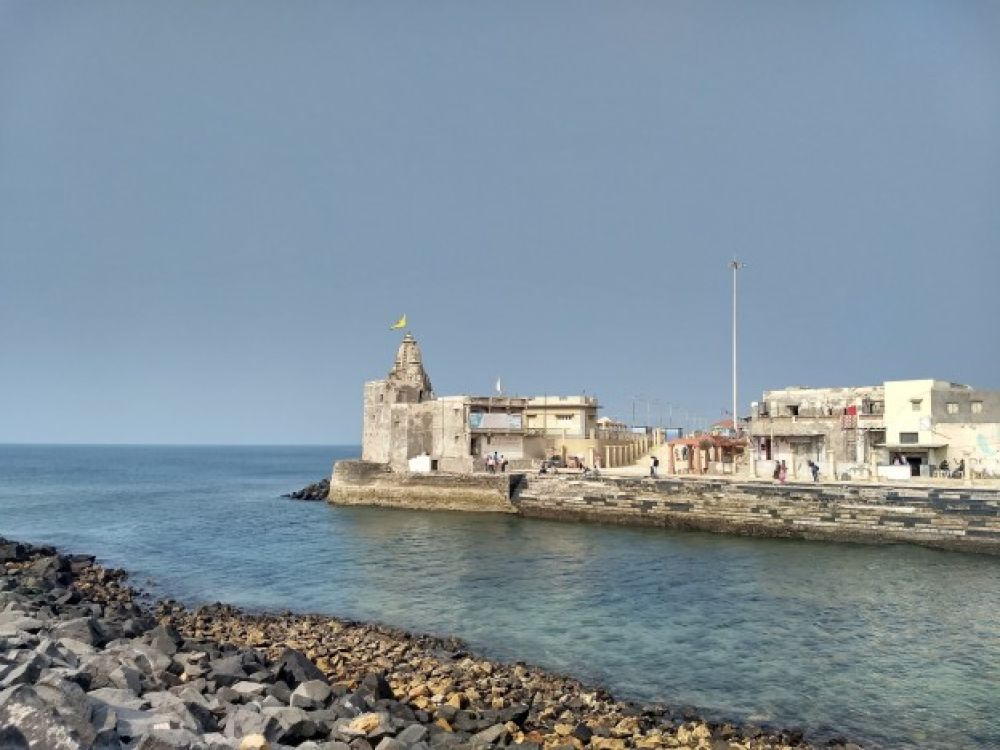

Samudra Narayana Temple, also known as Sangam Narayana, is a lesser-known but significant temple located in the ancient city of Dwarka, Gujarat. This sacred temple is dedicated to Lord Vishnu and is reputed to be the place where the mighty river Gomti meets the ocean. It marks a confluence of mythological and historical importance, forming an essential part of Dwarka's pilgrimage circuit.
The history of Samudra Narayana Temple can be connected to the legendary city of Dwarka, mentioned in the Hindu epic Mahabharata. The city is considered one of the four principal holy places (Char Dham) and seven ancient towns (Sapta Puri) to visit for spiritual liberation. The temple's existence dates back several centuries, although it's challenging to pinpoint its precise age. It represents the intertwining threads of spirituality, nature, and the belief in the divine, characteristic of Hindu tradition. Over the years, the temple has seen renovations and restorations, yet it stands as an emblem of the ancient Vedic culture that predominates in Dwarka.
Tourism in Dwarka has deep religious roots, with people traveling here to get a glimpse of the ancient kingdom of Lord Krishna. Dwarka, as a center of worship, not only boasts the famous Dwarkadhish Temple but also plays host to a series of other significant historical and religious sites, including the Samudra Narayana Temple. Visitors come to witness the serene confluence and seek blessings at this seaside temple.
In recent years, the Gujarat government and various tourism bodies have worked towards improving the infrastructure and facilities around Dwarka to manage the increasing influx of pilgrims and tourists. These efforts include enhanced accommodation options, better transportation links, tourist information centers, and clean-up drives to maintain the sacred and natural charm of the region.
The latest trends in tourism around the Samudra Narayana Temple and Dwarka include an emphasis on sustainable tourism practices. There is a growing consciousness about preserving the natural and historical sites for future generations. Besides, there is also an increasing interest in experiential travel, where tourists are seeking more immersive experiences, such as participating in local festivals, understanding the cultural heritage, and joining in the evening aartis (prayer offerings) by the Ghats.
Moreover, the digitalization of travel services has made information more accessible, and online bookings for accommodation and travel have streamlined tourism. Seasonal trends also play a role, with the period from October to March being the peak season due to favorable weather conditions.
When planning a visit, it’s important for tourists to note that Dwarka is a city steeped in ritualistic tradition. Respect for local customs and attire is appreciated when visiting Samudra Narayana Temple and other holy sites. Photography may be restricted in certain areas to preserve the sanctity of the temple. Accommodation ranges from basic guest houses run by temple trusts to more modern hotel facilities, catering to the needs of both pilgrimage and leisure travelers.
The Samudra Narayana Temple remains a timeless jewel in Dwarka’s illustrious spiritual landscape. Both the history of tourism and contemporary trends reflect the continuity and change in how we experience such ancient places. It transcends mere sightseeing and offers a dip into the ocean of spiritual awakening, leaving visitors with a profound sense of peace and fulfillment.